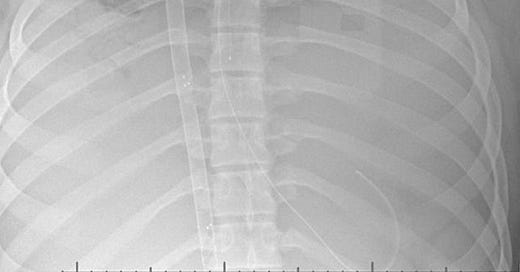An update on the critically ill in Canadian teen with H5N1. Death narrowly averted.
That and other stories in "Five on Friday" for January 3, 2025...

Item 1: Canadian teen with H5N1 no longer requires life support—but almost died. Plus, a more reassuring update on US cases this fall.
In November, authorities in British Columbia, Canada announced that a previously healthy teen had become infected with H5N1 influenza (bird flu) and was very ill. The child had no significant underlying medical problems, and how the child became infected remains unknown.
A new report in the New England Journal of Medicine makes it clear just how sick this child became. After initially being seen and sent home from an ER with fever and conjunctivitis (pink eye), she returned a couple days later with cough, vomiting, and diarrhea and was admitted to the hospital for respiratory distress and “hemodynamic instability”—which likely refers to a dangerously low blood pressure. She was found to have pneumonia. After initially needing supplemental oxygen delivery with pressure (a more complicated version of CPAP), she was eventually intubated and placed on a breathing machine for mechanical ventilation.
She then developed ARDS (acute respiratory distress syndrome), which many illnesses can cause and which is life-threatening. Things got so bad that she was placed on ECMO—a kind of lung bypass that is reserved for life-threatening conditions in otherwise healthy people who generally do not otherwise carry a high risk of morbidity and mortality. Her kidneys also failed, requiring dialysis.
She received a barrage of medical treatments, including antivirals, antibiotics, and a blood treatment that is highly unusual for influenza cases called plasma exchange. In other words, the kitchen sink.
The patient was of course found to have H5N1, the D1.1 variant which also caused the other severe case we know about during the 2024 outbreak. No other pathogens (including bacteria) were detected, despite extensive testing.
It is something like a miracle that this child is alive, and no longer requiring these medical interventions. It is also good that nobody caught this from her. If the D1.1 variant gains the ability to transmit from person to person, 2025 could be a bad year.
Meanwhile, another report in the New England Journal covering 45 mild cases of H5N1 among poultry and cattle workers was more reassuring, with no hospitalizations required. It’s unclear whether this reflects a milder variant (the B3.13 variant) or something about the health of the infected people. However, the only medical risk the Canadian teen had was mild-to-moderate obesity.
Item 2: New year, new Covid, Flu, RSV dashboard!
Here at Inside Medicine, we always say that scientia est potentia, “knowlege is power.” That’s why we made our dashboard that tracks Covid, influenza, and RSV and update it weekly.
Late last year, the federal government enacted a new rule again requiring hospitals report information on their bed and intensive care capacity and data on Covid, flu, and RSV hospitalizations. The new data actually exceeds some of what we previously had during the Covid emergency period; for the first time, we now have state-level information on RSV and flu hospitalizations.
So, Benjy Renton has updated our dashboard. Now, Covid, flu, and RSV hospitalizations by state can be found in one graph on the front page of the dashboard. Detailed demographic information is not included in the new data, so we’ve maintained the link to the previous CDC data resources that provide rates by age, race, and sex at the national level.
We’ll continue to add functionality to the dashboard if there’s interest.
Item 3: Marburg outbreak in Rwanda declared over.
There are fewer diseases scarier than Marburg Virus. Like its relative Ebola Virus, it has a high fatality rate. That said, it’s far more possible to control than respiratory pathogens. Still, it takes tremendous effort and the right resources to contain an outbreak of Marburg.
Rwanda got it done. In a short but impactful essay in the Telegraph, my friend and colleague Dr Tsion Firew describes her experience at the frontline of the outbreak this fall. The contrast between her experience in Rwanda and that of her experience as an ER doctor in the US early in Covid is remarkable. “I was working in New York City’s Emergency Department in March 2020 when Covid-19 overwhelmed our hospitals. Back then, there was no preemptive testing or screening, even in the international airports,” she wrote.
Indeed, the big differences (other than biological ones) came down to resources like test availability, alertness to the emerging threat, and effective collaborations between local, national, and international agencies.
To crystallize this all, consider this: Dr. Firew was exposed to Marburg during the outbreak. Thanks to the availability of testing, she was tested (and was negative) and therefore quickly able to return to work, rather than being forced to wait out a long quarantine period.
Item 4: Q&A with a bipartisan ER doctor who narrowly lost Congressional bid.
When I was a medical student, I met a young attending in the New York ER where I was training named Dr. Amish Shah. Fast forward to 2024, and Dr. Shah had become a power player in the Arizona State House, having made a name for himself as a voice of reason with a record of bipartisan bills.
After winning a crowded Democratic primary, he came close to winning a seat in the US House of Representatives. I spoke to him about his journey from being an ER doctor (which he still does) to advocacy and politics for the Annals of Emergency Medicine. While Dr. Shah did not win his election, his approach to politics is refreshingly open and, by all accounts, remarkably effective. Have a look at our Q&A, and let me know what you think!
Item 5: Poll of the Week results.
Here are the results to the last poll. The correct answer was Italy!
Item 5a: Poll of the Week!
Among US children ages 5-17, influenza and pneumonia (combined) causes between 100-200 deaths per year. …
That’s it. Your “Friday Five!” Questions? Comments? Please chime in!
Feedback! Have any ideas for next week’s Poll of the Week? Any great articles you’ve read elsewhere that you want to share with the Inside Medicine community?







I did read that the recovering... thankfully...13 y/o was somewhat over-weight...not likely a qualifier for comorbitity. I don't have access to the NEJM article did this or any other existing health status impact her illness?
I read something today that said there’s an outbreak of human metapneumovirus in China anyone know anything about this ?